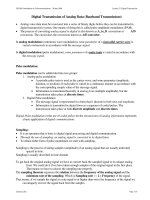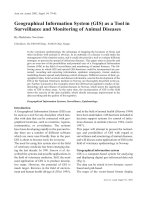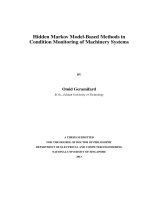Routine Monitoring of Surveillance Data
Bạn đang xem bản rút gọn của tài liệu. Xem và tải ngay bản đầy đủ của tài liệu tại đây (253.46 KB, 14 trang )
<span class="text_page_counter">Trang 1</span><div class="page_container" data-page="1">
Routine Monitoring of Surveillance Data
<small>Matt Moore, Resident Advisor Field Epidemiology Training Program </small>
</div><span class="text_page_counter">Trang 2</span><div class="page_container" data-page="2">The surveillance cycle
<b><small>Reporting / </small></b>
<b><small> Data Collection </small></b>
<b><small>Analysis, </small></b>
<b><small>Interpretation Action! </small></b>
<b><small>Evaluation </small></b>
<b><small>Diagnosis / Detection </small></b>
<b><small>Communicating Information </small></b>
</div><span class="text_page_counter">Trang 3</span><div class="page_container" data-page="3">Monitoring: Learning Objectives
At the end of this session, you will be able to:
• Identify indicators and targets for a surveillance system
• Use indicators and targets to monitor the quality of surveillance
</div><span class="text_page_counter">Trang 5</span><div class="page_container" data-page="5">What are all of the steps that must take place for an individual case to be captured by national surveillance?
</div><span class="text_page_counter">Trang 6</span><div class="page_container" data-page="6">What are all of the steps that must take place for an individual case to be captured by national surveillance?
<small>Person develops disease </small>
<small>Person seeks medical care</small>
<small>Person is evaluated (physical exam, lab tests) </small>
<small>Evaluation is done correctly </small>
<small>Case definition is applied correctly </small>
<small>Case reported by health facility to next level </small>
<small>Case is reported to national level </small>
<small>A problem in any part of the system can create problems for the whole system. </small>
<small>Monitoring is an important part of ensuring high-quality surveillance. </small>
</div><span class="text_page_counter">Trang 7</span><div class="page_container" data-page="7">For surveillance systems, what is the difference between monitoring and evaluation ?
• Monitoring: Routine and continuous tracking of the implementation of surveillance activities and of the overall performance of
surveillance and response systems.
Are we doing what we said we would do? Are we doing it well?
• Evaluation: Periodic assessment of the relevance, effectiveness and impact of activities in the light of the objectives of the surveillance and response systems.
Is the surveillance system effective and useful?
If not, can it be improved so that it is effective and useful?
</div><span class="text_page_counter">Trang 8</span><div class="page_container" data-page="8">Indicators and Targets
<b><small>Indicator </small></b>
<small>• Variables that can: </small>
<small>• Provide information regarding the status of the system </small>
<small>• Be measured repeatedly over time • Identify areas for improvement </small>
<small>• Must be interpreted in context of other sources of information (e.g. supervisory reports). </small>
<small>• Example: Is reporting done on time? </small>
</div><span class="text_page_counter">Trang 9</span><div class="page_container" data-page="9">What indicators could be used to monitor performance?
<small>Health Facility Reporting Practices </small>
<small>District or Provincial Reporting </small>
<small>Practices Disease Data </small>
<small>Laboratory Practices </small>
<small>Proportion of outbreaks notified to the next higher level within 2 days </small>
<small>Proportion of districts and provinces that report laboratory data to the next higher level Proportion of health </small>
<small>facilities submitting numbers of cases of </small>
<small>epidemic-prone diseases </small>
<small>Number of epidemics missed by district (detected by national level) </small>
<small>Proportion of confirmed outbreaks with a </small>
<small>recommended public health response </small>
<small>Proportion of provinces reporting laboratory data to national lab </small>
</div><span class="text_page_counter">Trang 10</span><div class="page_container" data-page="10">Monitoring Exercise (10 minutes work, 10 minutes presentation/discussion)
<small>Health </small>
<small>Facility Jan Feb Mar Apr May Jun Jul Aug Sep Oct Nov Dec </small>
<small>T/N (%) </small>
<small>(N-M)/N (%) A L T T L L T T L L L L M B T T T L T T T L T T T L C M L L M L M L L M L T T D T T T T T T T L T T L T E L L L M T L M M L T L M F T T T T T L L T T T L L G T T T T T L T T T T T T H M M M M M L L M L M M L </small>
</div><span class="text_page_counter">Trang 11</span><div class="page_container" data-page="11">Questions
<small>1. Calculate the timeliness of reporting for a health facility in the district. </small>
<b><small>Record your answer in the second to last column, labeled T/N. T means on time and N means total number of reports . </small></b>
<small>2. Calculate the completeness of reporting for a health facility and record </small>
<b><small>the answer in the last column, labeled (N-M)/N. N means the total number of reports and M means the number of reports missing/not </small></b>
<small>received. </small>
<small>Then, as a group, please answer the following questions: </small>
<small>3. How many facilities reached the target of 80% timeliness? 4. Which health facility is the best in terms of timely reporting? </small>
<small>5. The target for completeness is 80%. How many health facilities have reached or passed the target? </small>
</div><span class="text_page_counter">Trang 12</span><div class="page_container" data-page="12">Monitoring Exercise
• For the surveillance system that you will evaluate:
<small>• What surveillance indicators are used? </small>
<small>• If you are not sure, what surveillance systems should be used? </small>
</div><span class="text_page_counter">Trang 13</span><div class="page_container" data-page="13">• Monitoring is essential to maintain quality.
• Established indicators are available for monitoring performance of reporting sites.
• Monitoring and evaluation should be used to develop strategies for improvement of surveillance systems.









